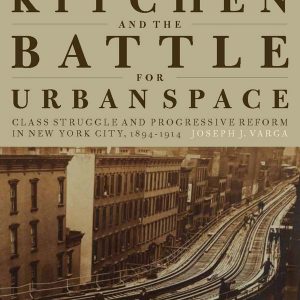Antipode: A Radical Journal of Geography
August 2013
Filip Stabrowski
Department of Anthropology, Hunter College, City University of New York
Joseph J. Varga, Hell’s Kitchen and the Battle for Urban Space: Class Struggle and Progressive Reform in New York City, 1894-1914, New York: Monthly Review Press, 2013. ISBN: 978-1-58367-348-5 (paper); ISBN: 978-1-58367-349-2 (cloth)
Despite recent efforts to efface its history through the practice of renaming, the area of mid-west Manhattan that real estate agents now call the Clinton Historic District (or even ‘Clinton Heights’) remains – to many existing residents and to the popular imagination at large – Hell’s Kitchen. Just how and why this moniker and all that it conjures have stuck is part of the story that Joseph Varga tells in Hell’s Kitchen and the Battle for Urban Space, a nuanced and theoretically-sophisticated history of the social relations and spatial imaginaries that produced this area in the turbulent decades from 1894 to 1914. Though this period of American urban history – the era of Progressive reform – has received considerable attention from historians, Varga adds a much-needed dimension to the discussion by engaging directly with critical spatial theory. The result is not just an eminently readable history of Hell’s Kitchen, but a fascinating example of how ‘taking space seriously’ can alter our historical understandings and perspectives in powerful ways.
Focusing on Hell’s Kitchen as a crucible of Progressive urban reform ideas and practices, Varga explores how a combination of “forces” – including the physical features of the area itself, the social relations of work and residence, the profit motives of employers and landlords, and outside perceptions of space and behavior by government officials and social reformers – had produced not just a particular kind of space (or kinds of spaces), but the very categories and prisms through which individuals (residents and reformers alike) apprehended and transformed these spaces. Space, for Varga, is both the outcome of capitalist processes of accumulation and the “primary ontological condition” of understanding and acting in the world. The generative nature of space can best be understood, he suggests, through an exploration of how space is produced – physically, socially, and symbolically.
Here Varga invokes Henri Lefebvre’s well-known spatial triad of lived, conceived, and perceived space – three ‘levels’ of space that intersect and interpenetrate each other. Lefebvre’s key theoretical breakthrough, argues Varga, lay with his notion of perceived or representational space – that which mediates (by both linking and de-linking) between conceived space (the abstract space of power and planning) and lived space (the spatial ‘codes’ through which the built environment is navigated, negotiated, and recreated). Representational space is significant because, for Varga, it serves as the “location of possibility” for relative freedom of action; though conditioned by the ideology of conceived space and the quotidian nature of lived space, it ultimately resists both. What preserves this space of possibility within any dominant mode of production is quite simply history – the pre-existing conditions (including customs, languages and practices) in which all cultural production occurs. For Varga, however, these histories are not determinate but, rather, open up a realm of contingency and opportunity – a space in which there are no political guarantees, but through which new subjectivities are necessarily produced…

Comments are closed.